Prawn Nasi Goreng is a savory and fragrant Indonesian fried rice made with dried shrimp spice paste, kecap manis, and eggs. The rice is fried to be charred slightly on the edges and is served with either egg omelet ribbons or fried eggs and/or fried onions! This recipe is so easy to make that you can make it on weeknights!
What is Nasi Goreng?
Nasi Goreng is Malay for fried rice: nasi is ‘rice’ and goreng means ‘fried’. Once you understand that, it is natural to assume that all fried rice can be called Nasi Goreng. But that is not strictly true. Fried rice is universal throughout Asia, especially in Southeast Asia. It, therefore, follows that Cantonese fried rice is different from Thai basil fried rice, which is a world apart from Nasi Goreng. In fact, the only common bind behind all these dishes is that the ingredient is rice and the method of preparing them involves frying.
Having sampled variations of fried rice from Japan to Indonesia, my all-time favorite fried rice is a version that I had at a small restaurant in Bali. Even though it was over twenty years ago, this dish still brings back happy memories of basking in an idyllic, tropical paradise and eating this dish on the shores of Lake Batur (Danau Batur) at the foothills of Mount Batur. What made this dish different from the other versions that I tried was the composition of the sambal terasi. Indonesian Nasi Goreng is not Indonesian if it does not have this key ingredient.
What is sambal?
Sambal is a catchall phrase that covers a variety of sauces, mostly involving some form of chili but expands to cover a list of other ingredients including ground dried shrimp, garlic, onions and shallots, palm, and other types of sugar, galangal or ginger, and a citrus or acidic element. The phrase itself has its origins in Indonesia but has quickly expanded across Southeast and South Asia so that there is no single sambal as such.
Along with the geographical translocation, virtually every family has its own version of sambal. In my case, the sambal terasi that is used in this recipe is a combination of an heirloom sambal belacan recipe which is a combination of my husband’s Malaysian grandmother’s recipe and the version from that little Balinese restaurant. The composition and proportions of dried shrimp paste, Thai chilis, garlic, jaggery, salt, and of course, limes and/or lemons are completely unique. And yes, you read that right, I said limes and/or lemons.
I say this because colloquially ‘limau’ in Malay refers to lemons, and one can refer to different kinds of ‘limau’ based on the context of the dish. One generally uses lemons in sweeter dishes or desserts (key limes are an exception), whereas limes are more common in savories (garnishing lemons on fish and chips is an exception).
Types of limau found in Indonesia and Malaysia:
- Limau Bali – Pomelo.
- Limau Gedang – Grapefruit.
- Limau Kasturi- Calamansi.
- Limau Langkat – Mandarins
- Limau Manis – Orange
- Limau Nipis – Key Lime
- Limau Perut – Kaffir Lime
Key components in the Prawn Nasi Goreng:
As you can see, the phrase ‘limau’ covers a wide variety of citrus. This brings me to the first inflection point in this recipe. While many recipes call for the use of Kaffir lime, in my opinion, nothing beats the Calamansi (Limau Kasturi) for this dish. Calamansi is acidic and has a slightly bitter tinge, and I would describe the flavor as a mixture of lime and blood orange. The addition of Calamansi, adds a completely new dimension to the flavor profile of the terasi. I have used it to make the Nasi Goreng while we were living in Singapore. This is hard to find here in California, and I did not have any kaffir lime leaves, so I added some lime zest.
The second key component of Nasi Goreng is the use of kecap manis or sweet sauce. While it is commonly sold as a soy condiment, be aware, that just because it is soy-based, it is not soy sauce within the general Asian cooking context, as there are different types of soy sauces. Kecap manis is distinct, it is thick, and it is sweet as I have used in my Char Kway Teow. Please be careful of substituting ‘dark soy’ for kecap manis in this dish. Adding sugar to an already sodium and sugar-rich sauce will make this dish super sweet. Instead, you can substitute hoisin sauce which consists of soybeans, five-spice powder, garlic, red chili peppers, and sugar. It presents a more authentic flavor.
The final component of a great Nasi Goreng is the rice itself. Bali is famous for its rice or ‘padi’ terraces. I do not believe that there is anything more sacred in Bali than the rice itself. In fact, it would not be an understatement to say that the Balinese view rice as a gift from their Gods. They grow many varieties of rice in Bali, including the common white, and the rarer red and black rice. While there are many varieties of rice, the more common commercial varieties are Jasmine or Basmati. While both are long grain, that is where the commonality ends.
Differences between Jasmine and Basmati rice:
| Type | Jasmine | Basmati |
| Origin | Southeast Asia | South Asia |
| Shape | Rounded and gentle edges | Elongated and sharper edges |
| Cooked Texture | Stickier because it has more amylopectin and less amylose | Less sticky because it has less amylopectin and more amylose |
| Flavor | Smells of sweet flowers | Smells like buttery popcorn |
| Age | Fresher is better | Aged is better |
| Glycemic Index | 60 (Medium GI) | 50 (Low GI) |
| Glycemic Load | 44 (High GL) | 37.5 (High GL) |
I hope you enjoy making this Prawn Nasi Goreng. By the way, the dish that I had in that restaurant in Bali kept it simple. There was rice, some tofu, and a garnish of egg ribbons. Nothing fancy but so tasteful! From my pen to your table, Bon Appetit!
Frequently Asked Questions:
Should I use day-old rice to make Nasi Goreng?
The short answer is yes, it is preferable. When one chills the rice, it undergoes a process called retrogradation, where the chilling effect causes starch molecules to harden, creating crystalline structures that allow the rice to be recooked when frying. So if you plan on using fresh rice, please do not overcook it. Cool the rice on a tray and refrigerate for at least half an hour. Freshly overcooked rice is soft and no matter how dry the rice is, it can be mushy. Some chefs would argue that freshly cooked and chilled rice is best for fried rice, and I agree. In a nutshell, day-old rice or fresh rice that has been chilled will work as long as the rice is not too dry nor mushy or clumpy.
Can brown rice be used to make Nasi Goreng?
Yes, brown rice is not a different rice variety, it is just unprocessed rice. White rice is brown rice that has been milled and polished, thus removing the husk, bran, and germ layers that constitute the higher fibrous content of the rice grain. While this shortens the shelf life of rice, brown rice takes longer to cook. Brown rice is more nutritious than white rice because it has higher fiber content and is not processed. That said, be aware: My daughter pointed out that she had researched and found that some studies show that brown rice has 80 % more inorganic arsenic in its husks. The polishing process removes a large portion of this inorganic arsenic.
What is the traditional version of the Nasi Goreng?
There are similar iterations of the Prawn Nasi Goreng in Malaysia, Singapore and Indonesia. Traditionally Nasi Goreng is made only with rice, kecap manis and the spice paste, without veggies or meat. But in Southeast Asia, this fried rice is made with a protein and one or two veggies. Dried shrimp is essential to give it a more authentic taste, or else it is just fried rice and not Indonesian fried rice. The umami from the shrimp paste and the dark brown color from the kecap manis make the Nasi Goreng unique.
Ingredients:
- Spice paste: Dried shrimp with chili and garlic
- Protein: Prawns, shrimp or chicken
- Veggies: Cabbage, peas or carrots
- Rice: Basmati, long grain or jasmine
- Eggs: Omelet ribbons or fried eggs with sunny side up
- Sauce: Kecap manis, soy sauce
- Fat/oil: Peanut oil, canola or sunflower oil
How to make Prawn Nasi Goreng:
- Soak the ingredients for the spice paste in 1 tablespoon of warm water and grind to a paste in a coffee or spice grinder. Heat a large wok and add the peanut oil and fry the spice paste until fragrant for a minute or two.
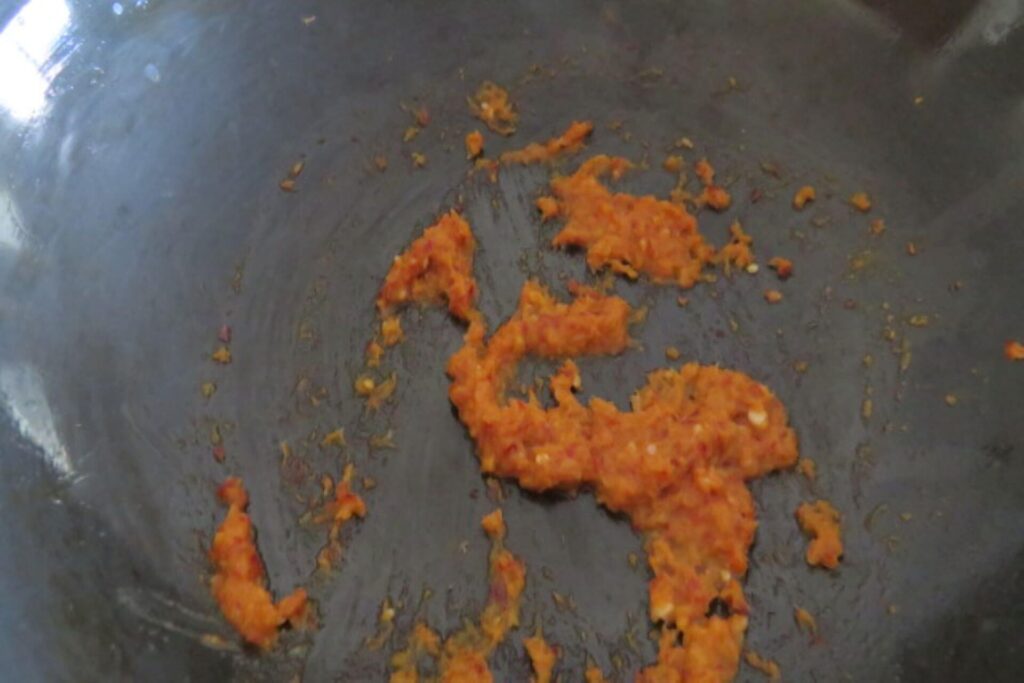
2. Add the cleaned shrimp and peas and sauté for 3 minutes.
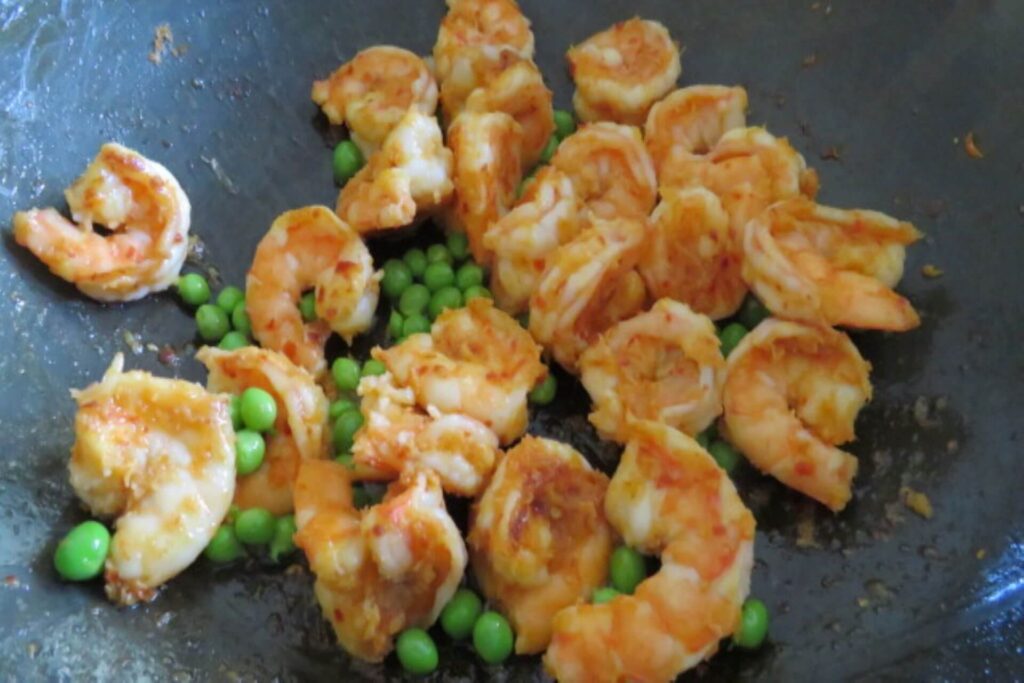
3. Add the cooled rice and fry on high heat for some charred edges on the rice.
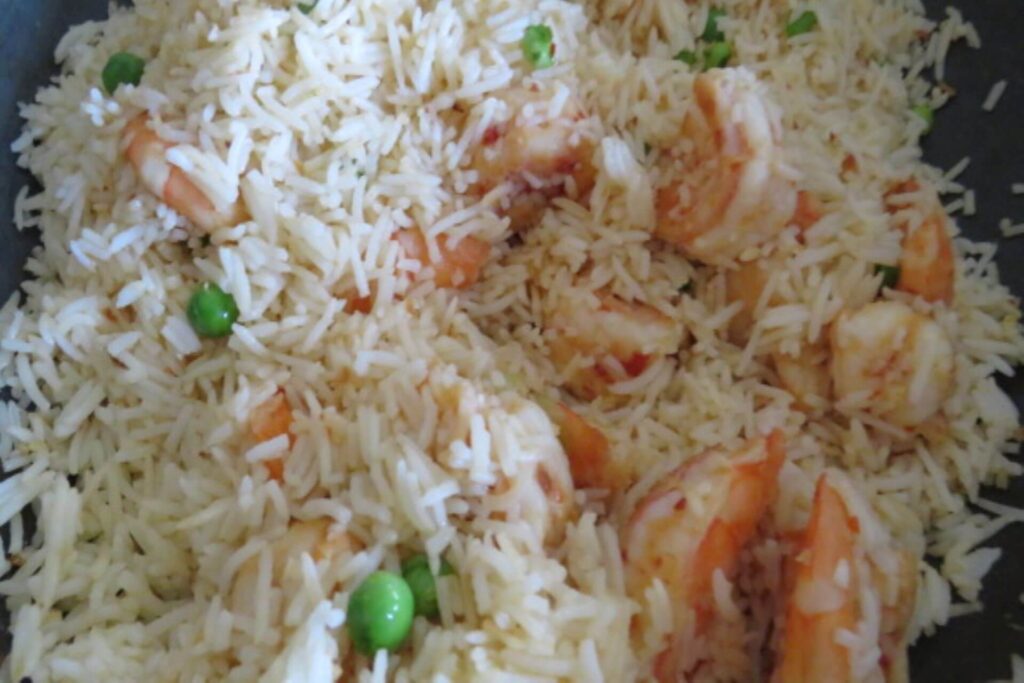
4. Add the sauces, fry again for a minute and turn off the heat. Add the cabbage and mix well.
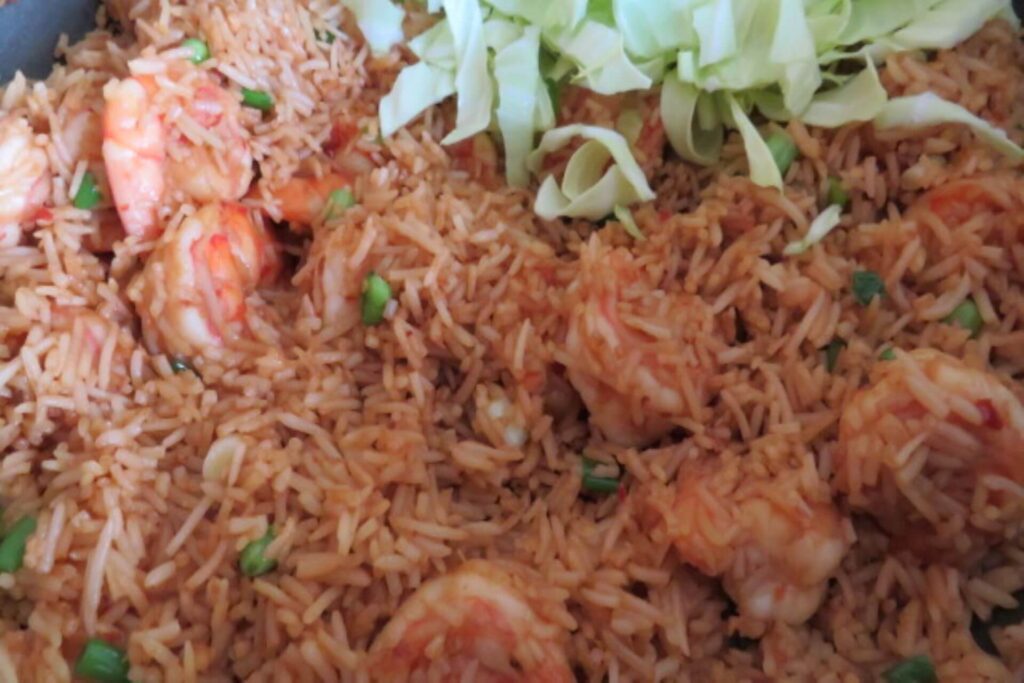
5. Fry the beaten eggs in hot peanut oil and swirl the wok to form thin omelets, and cut into ribbons or thin strips and keep aside for garnish. Serve the Prawn Nasi Goreng hot, garnished with egg ribbons or fried eggs with crispy edges and with a side of cucumber, lettuce, and scallions or fried onions on top.
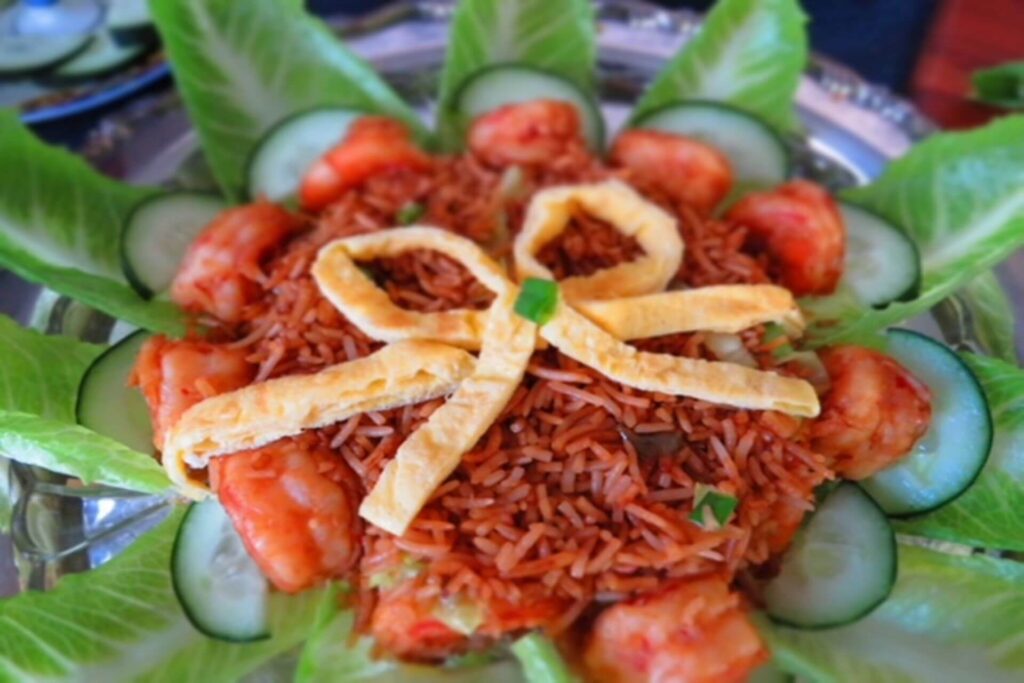
1. If you are using freshly cooked rice, then cool it on a tray for an hour before using in the fried rice. Day-old rice or rice cooked the previous day can be used, but it tends to become dry and some times even chewy. The bottom line is that the rice must not be sticky but firm individual grains. Remove any clumps using a fork and chill the rice before frying.
2. Kecap manis is essential for a more authentic flavor. If you cannot find it, just take (equal quantities) quarter cup of soy sauce and quarter cup of coconut palm sugar with a teaspoon of molasses and mix them together. Use this as a substitute for kecap manis or try hoisin sauce.
3. Stir fry the rice and the prawns on high heat to get a slightly charred coating on the rice.
Serving suggestions:
Serve the Prawn Nasi Goreng with egg omelet ribbons or fried egg with sunny side up along with cucumber and tomato slices on the side. You could also serve with these Indonesian salads:
- Rujak Recipe
- Indonesian Gado Gado (without the rice)
- Baked Tofu Stuffed With Beansprouts
Storage:
Prawn Nasi Goreng can be refrigerated for a day and frozen for three months in an airtight container.
Prawn Nasi Goreng
Equipment
- Wok
Ingredients
For the spice paste:
- 6 dried shrimp
- 3 dried red chili
- 1 birds eye chili
- 3 garlic
- 1 lime zest optional
For the fried rice:
- 1 tbsp peanut oil
- 4 cup basmati rice cooked, cooled
- 4 scallion chopped
- 1 lb prawn deveined without tails
- 3 leaves cabbage julienned
- ¼ cup fresh peas
- 2 tbsp light soy sauce
- 3 tbsp kecap manis
- 5 egg beaten
Instructions
- Soak the ingredients for the spice paste in 1 tablespoon of warm water and grind to a paste in a coffee or spice grinder. Heat a large wok and add the peanut oil and fry the spice paste until Fragrant for a minute or two.
- Add the cleaned shrimp and peas and sauté for 3 minutes.
- Add the cooled rice and fry on high heat for some charred edges on the rice.
- Add the sauces, fry again for a minute and turn off the heat. Add the cabbage and mix well.
- Fry the beaten eggs in hot, shimmering peanut oil and swirl the wok to form thin omelets, cut into ribbons or thin strips and keep aside for garnish.
- Serve the Prawn Nasi Goreng hot, garnished with egg ribbons or fried eggs with crispy edges and with a side of cucumber, lettuce, and scallions or fried onions on top.
Notes
- Fried onions can be made at home using onion rings or slices coated with cornstarch and shallow or deep fried in oil or even air fry until crispy. You could also use store-bought fried onions that is available in Asian supermarkets.
- Vegetables are optional in this fried rice.
Nutrition


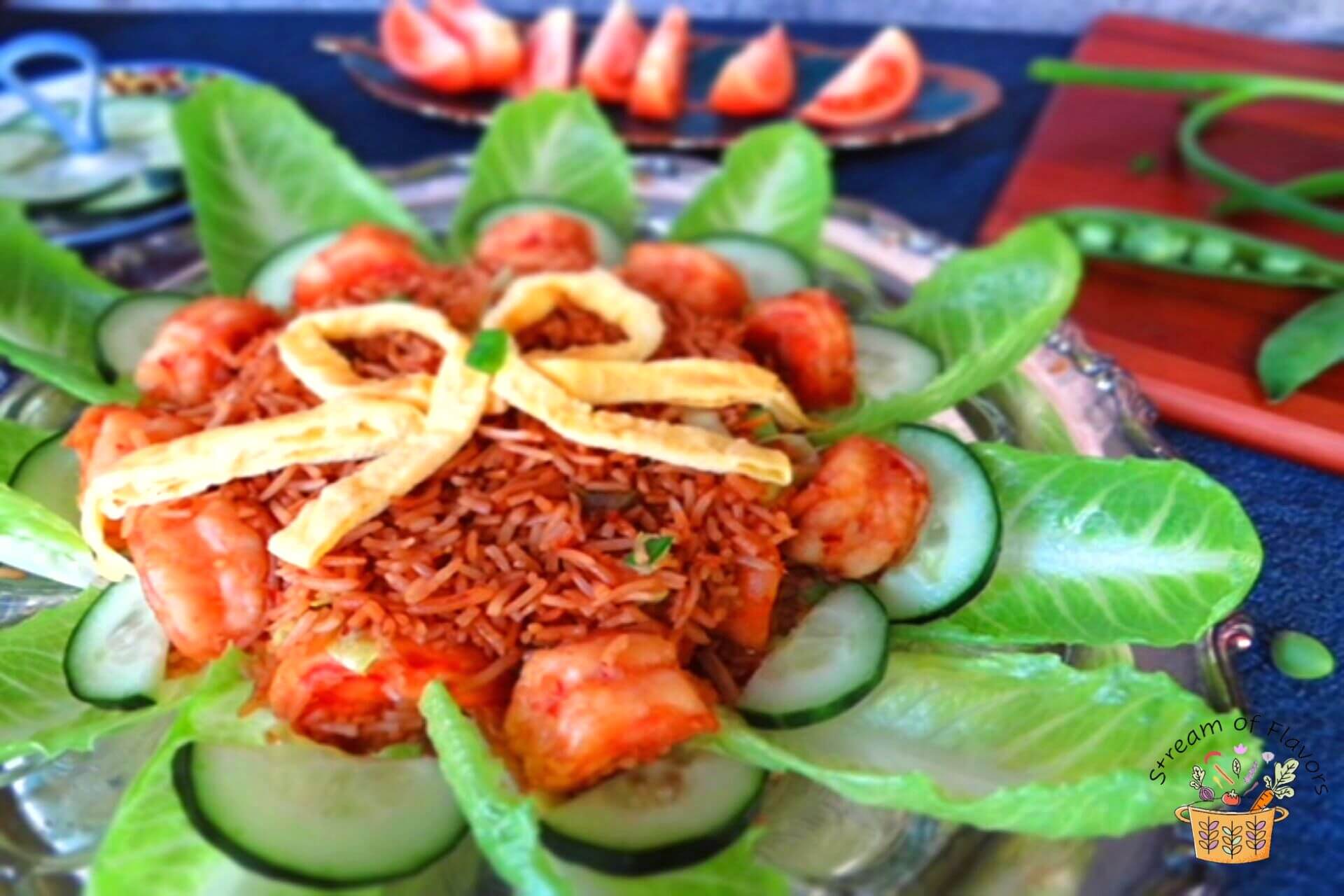
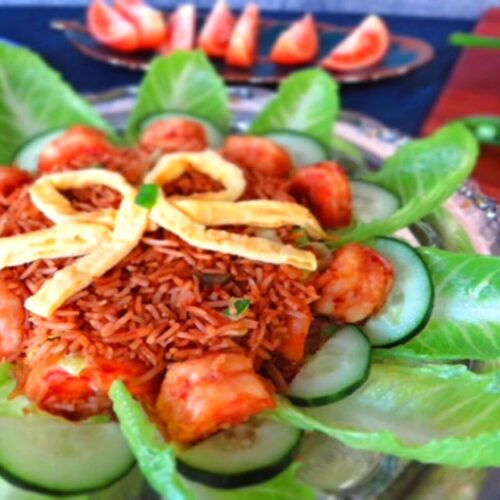
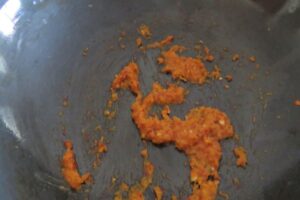
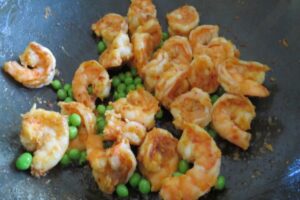
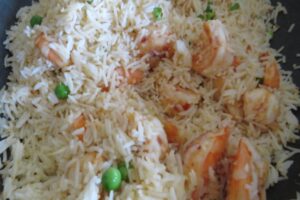
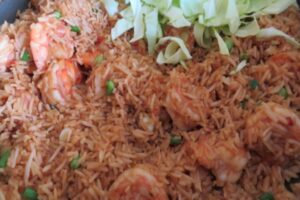

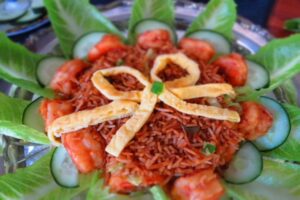





















0 Comments